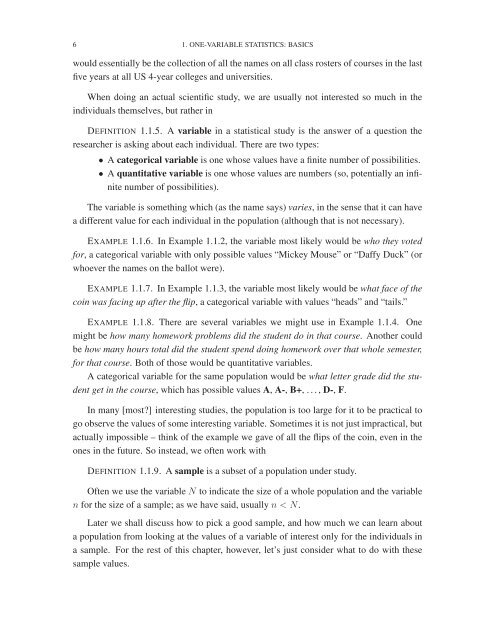Lies, Damned Lies, or Statistics- How to Tell the Truth with Statistics, 2017a
Lies, Damned Lies, or Statistics- How to Tell the Truth with Statistics, 2017a
Lies, Damned Lies, or Statistics- How to Tell the Truth with Statistics, 2017a
You also want an ePaper? Increase the reach of your titles
YUMPU automatically turns print PDFs into web optimized ePapers that Google loves.
6 1. ONE-VARIABLE STATISTICS: BASICS<br />
would essentially be <strong>the</strong> collection of all <strong>the</strong> names on all class rosters of courses in <strong>the</strong> last<br />
five years at all US 4-year colleges and universities.<br />
When doing an actual scientific study, we are usually not interested so much in <strong>the</strong><br />
individuals <strong>the</strong>mselves, but ra<strong>the</strong>r in<br />
DEFINITION 1.1.5. A variable in a statistical study is <strong>the</strong> answer of a question <strong>the</strong><br />
researcher is asking about each individual. There are two types:<br />
• A categ<strong>or</strong>ical variable is one whose values have a finite number of possibilities.<br />
• A quantitative variable is one whose values are numbers (so, potentially an infinite<br />
number of possibilities).<br />
The variable is something which (as <strong>the</strong> name says) varies, in <strong>the</strong> sense that it can have<br />
a different value f<strong>or</strong> each individual in <strong>the</strong> population (although that is not necessary).<br />
EXAMPLE 1.1.6. In Example 1.1.2, <strong>the</strong> variable most likely would be who <strong>the</strong>y voted<br />
f<strong>or</strong>, a categ<strong>or</strong>ical variable <strong>with</strong> only possible values “Mickey Mouse” <strong>or</strong> “Daffy Duck” (<strong>or</strong><br />
whoever <strong>the</strong> names on <strong>the</strong> ballot were).<br />
EXAMPLE 1.1.7. In Example 1.1.3, <strong>the</strong> variable most likely would be what face of <strong>the</strong><br />
coin was facing up after <strong>the</strong> flip, a categ<strong>or</strong>ical variable <strong>with</strong> values “heads” and “tails.”<br />
EXAMPLE 1.1.8. There are several variables we might use in Example 1.1.4. One<br />
might be how many homew<strong>or</strong>k problems did <strong>the</strong> student do in that course. Ano<strong>the</strong>r could<br />
be how many hours <strong>to</strong>tal did <strong>the</strong> student spend doing homew<strong>or</strong>k over that whole semester,<br />
f<strong>or</strong> that course. Both of those would be quantitative variables.<br />
A categ<strong>or</strong>ical variable f<strong>or</strong> <strong>the</strong> same population would be what letter grade did <strong>the</strong> student<br />
get in <strong>the</strong> course, which has possible values A, A-, B+,...,D-, F.<br />
In many [most?] interesting studies, <strong>the</strong> population is <strong>to</strong>o large f<strong>or</strong> it <strong>to</strong> be practical <strong>to</strong><br />
go observe <strong>the</strong> values of some interesting variable. Sometimes it is not just impractical, but<br />
actually impossible – think of <strong>the</strong> example we gave of all <strong>the</strong> flips of <strong>the</strong> coin, even in <strong>the</strong><br />
ones in <strong>the</strong> future. So instead, we often w<strong>or</strong>k <strong>with</strong><br />
DEFINITION 1.1.9. A sample is a subset of a population under study.<br />
Oftenweuse<strong>the</strong>variableN <strong>to</strong> indicate <strong>the</strong> size of a whole population and <strong>the</strong> variable<br />
n f<strong>or</strong> <strong>the</strong> size of a sample; as we have said, usually n

















